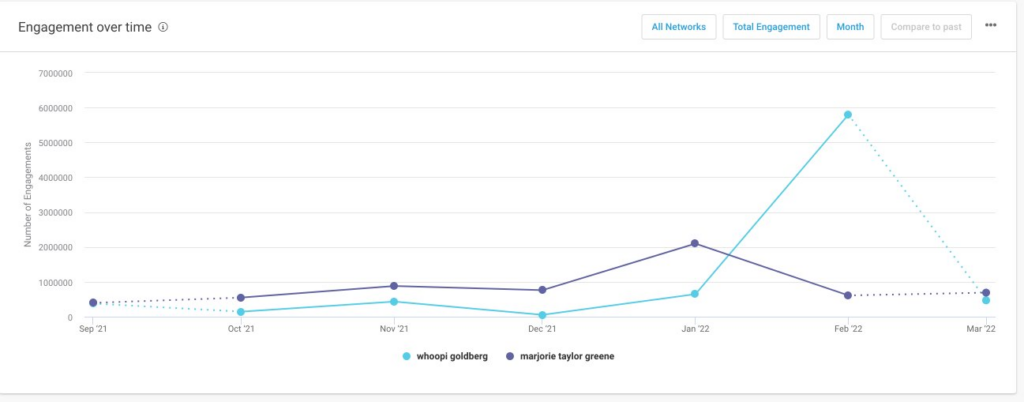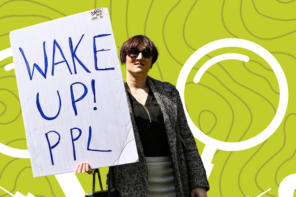Earlier this month, amid increasing death threats, the synagogue of the judge who signed the FBI’s Mar-a-Lago search warrant was forced to cancel its Shabbat service. And this is hardly an isolated incident. Antisemitism is becoming more and more overtly accepted on the Right and in the Republican Party more broadly. Especially since the raid of Trump’s Florida estate, we’ve seen an acceleration of the rhetoric and increased calls for violence against Jews on pro-Trump sites. Right-wing antisemitism is increasing at a rate even experts weren’t ready for.
Yet we hardly hear an outcry compared to those in response to antisemitism on the Left.
More right wing antisemitism. This time from a Republican governor.
Let’s see if anyone responds as much to this danger as they do when a Black woman on the View makes an honest mistake and apologies. https://t.co/TmLe79voUy
— Elad Nehorai (@EladNehorai) August 10, 2022
Why is this?
First, lest you think I’m exaggerating, the data pretty clearly establishes the fact that antisemitism on the Right isn’t discussed as much as the Left, and it’s true everywhere from social to mainstream media.
See, for example, this comparison of historical trends in discussions on Twitter around antisemitism:

And this study by Media Matters examining the coverage of antisemitism in mainstream media:

While the totals demonstrate a meaningful but modest focus on the Left (55% to 44%) in general, if we draw a distinction between action and rhetoric a different picture emerges. What we see is not only a notable 53% to 19% disparity in focus on the Left’s rhetoric, but a gigantic disparity between attention given to the actions of the Right (25%) and the Left (2%), suggesting that the Right is far more likely to act on its antisemitism (which is supported, once again, by the data).
My focus however is on one explanation often given by liberals and progressives even after I explain the danger of right-wing antisemitism, the lopsided media attention, and how the Right has manipulated much of our discourse through effective messaging and marketing: “I know the Right is antisemitic, but I’m more scared of it in my own camp.”
Understandable—but also deeply problematic and dangerous for a variety of reasons.
A false perception of danger
Many of those who focus on left-wing antisemitism don’t even take a “both-sides” approach: they actually say they will only call out the antisemitism they perceive in their own camp. The problem is that this unilateral approach creates a false perception of danger since the more we hear about a danger, the more we’re scared of it.
And this, in turn, has consequences they might not be aware of. For example, when Whoopi Goldberg falsely asserted that the Holocaust “wasn’t about race” she was suspended from The View, despite having apologized and demonstrated a genuine understanding of the issues involved. Yet, when, as journalist Annika Brockschmidt writes, “Marjorie Taylor Greene stood proudly next to a white supremacist and Nazi-sympathizer, Nick Fuentes, at his America First Political Action Conference (AFPAC), where he later praised Putin and Hitler,” there was virtually no fallout.
There was an intense spotlight on a Black woman who’d apologized, and almost none on an unrepentant white Republican woman who’d attended an event where Hitler was praised. Just the opposite, in fact. Despite lightly condemning her participation, House Minority Leader Kevin McCarthy reaffirmed his pledge to give her “better committee assignments” if Republicans retake the majority in the midterms. Only three years earlier, McCarthy had removed former Representative Steve King from his committee assignments due to a comment sympathetic to white supremacists.
Whether gauging the interest through Google trends:

…or through social media interest (source: BuzzSumo)…

…the simple reality is that a Black woman’s misstatement on the View got far more attention than a congresswoman’s attendance at a Neo-Nazi conference, an act that would have once been considered career-ending for a politician.
To those who would declare that this example is apples and oranges (one is a daytime TV host and actor while the other is a member of the House of Representatives), I respond: I agree completely. It is apples and oranges, and that’s exactly the issue. MTG is a person in actual power, not a TV personality. It means that there should have been far more traction for her story. Even if the traction was comparable, which it wasn’t, that alone would have been an injustice.
Cancel culture is just cultural boundaries
“But this doesn’t surprise me!” I often hear at this point. “Republicans don’t face consequences! At least with Democrats and hosts of The View you can do something!”
Even in a fractured society, we have to work to build consensus around what is and isn’t within the bounds of acceptable behavior—especially when it comes to those in power.
I recently interviewed Sarah Hightower, an expert on QAnon and what are known as “doomsday cults,” for an upcoming article about how hate spreads online. One point she made that stuck with me concerned the Tokyo subway attack in 1995. She described how the movement behind the attack, Aum Shinrikyo, was well known in Japan when the attack occurred, but that the movement and its supporters had not been ostracized.
After the attack, however, a cultural line was drawn: the group and anyone associated with it was ostracized and alienated. In America, when we attempt as a culture to preempt violence or mistreatment—sexual abuse, racism, etc.—by drawing a line in the sand, it’s often dismissed as “Cancel Culture.”
“Canceling” isn’t unique or new, and—perhaps most importantly—it’s not even an inherently bad thing. It’s part of how we communicate values critical for a functioning democracy and decide between which behaviors are acceptable and which are not. The Right, with a big assist from centrist and liberal pundits policing what they call “free speech,” has been incredibly effective at neutralizing this cultural need and at creating cultural boundaries that allow them to promote toxic ideologies and spread bigotry without consequence.
This is why trans people are being targeted: the Right has drawn their line in the sand.
And in so doing, they’ve affected the mainstream as well. Trans and queer rights are suddenly up for debate in the press; pundits debate the pros and cons on cable news and in op-eds. Democratic voters—usually white, often cismale—are also being influenced by the discussion, inflamed by wildly overblown fears of “things they can’t say” or of “getting fired for not being woke enough.”
The more the Right is able to successfully push its line in the sand further and further out, the more it feels empowered to enter other areas. This isn’t a stroke of genius. They’re just using what’s natural to cultures to their advantage. The Right is asserting its values by challenging the boundaries.
But the center and center-left in America, beholden to the concept of the “marketplace of ideas,” are still largely convinced they need to operate with the consensus of the Right; or, at least, that all conversations should be on the table. So they don’t create lines in the sand, they simply adjust to them.
The result is that the line keeps moving rightward.
More to the point, we’ve now seen numerous attacks associated with the Right, none of which have led to the ostracism of this set of ideas and movements or anyone associated with them. It’s as if we’ve had multiple Tokyo subway attacks without our culture drawing a clear and unequivocal line declaring that this is unacceptable.
For example, after President Trump blamed “many sides” for a white nationalist rally that led to a domestic terror attack and the death of counter-protester Heather Heyer, neither Trump nor those who defended his statements were ostracized. When the Right, including popular mainstream media figures like Tucker Carlson, spread nonstop antisemitic conspiracies about George Soros trying to “end civilization” by controlling the government (a conspiracy that directly contributes to violence), they meet with few or no consequences. When trans people are targeted daily by the Right, there’s hardly a whimper in response. When an insurrection occurs, the Republicans who called it “legitimate political discourse” remain in power.
There’s been plenty of criticism of course, but that’s not the point; the point is that we’ve left questions where there should be answers. The point is that we’ve abdicated our responsibility as a society to declare, in a (relatively) unified voice, that we refuse to even “have a conversation” about whether trans people have a right to exist, or whether it’s okay to demonize Jews, or whether a violent overthrow of the government is an acceptable component of our discourse.
This is why it’s so important to call out right-wing antisemitism instead of continuing to roll over and accept it. A line in the sand must be drawn just as the Right has done. Despite being a minority, the Right has managed to completely manipulate our discourse.
As a society we can’t keep adjusting to their rhetoric. And here’s perhaps the most important point: it’s not just about the well-being of Jews.
Lives are on the line
Antisemitism doesn’t just affect Jews. As many have pointed out, far from simply being a hatred of Jews or Judaism, antisemitism is a grand global narrative; it’s a story about the way the entire world functions. According to this conspiracy theory an all-powerful force is destroying “their” society, which justifies any response—including violence. If Soros is destroying the country by bringing in a flood of migrants, then hurting migrants and putting them in concentration camps is a patriotic act of self-preservation.
For some, antisemitism, in the form of the “Great Replacement” conspiracy, justifies mass violence, whether it’s the murder of 11 Jews in a Pittsburgh synagogue or the murder of 10 African Americans in Buffalo, New York. If the Jews are manipulating the country into losing its white majority and its Christian character, then killing people and democracy is a small price to pay to maintain control. This is exactly how a good deal of the Right talks—whether the rhetoric is overt or coded—and they’re emboldened by our culture’s failure to roundly condemn such messages.
So. We’re living through an emergency. In an emergency you don’t have nice debates about whether the house is burning down, you yell “Fire!” and you push everyone in the direction they need to go—rhetorically speaking. If we keep waiting, keep acting like nothing can be done, we will lose.
In other words, this is not the time to have polite disagreements. It is the time for “Cancel Culture”—i.e., lines in the sand. Firm and unequivocal call-outs of any and all antisemitism, without vacillation and without qualification. Activism to push leaders to do the same. Denouncements, not just of Republicans and the Right, but of those who give them platforms, from mainstream to social media. Like the Right, we need to start drawing lines in the sand and refusing to back down. Unlike the Right, however, we must do so without violence or the threat of it.
People will die. More people. We’ve already lost one million Americans, partly due to the government’s public health system being manipulated by the same dynamics as the ones I mentioned, and often due to similar and even interconnected conspiracy theories.
The mainstream are followers so they have to be pushed. We have to be loud. We need to amplify each other and spread the word. Right-wing antisemitism is an existential threat to the country and an immediate threat to Jews, Muslims, trans people, immigrants, and all vulnerable populations in the United States and beyond.
No more debates. No more worrying about your own camp. No more focusing solely on those who might do something about it. I’ll just say it: It’s time to cancel right-wing antisemitism.





